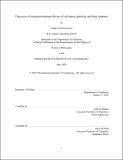Discovery of microenvironment drivers of cell states, plasticity and drug response
Author(s)
Navia, Andrew Warren
DownloadThesis PDF (101.1Mb)
Advisor
Shalek, Alex K.
Terms of use
Metadata
Show full item recordAbstract
Cell state can be influenced by both intrinsic and extrinsic factors with functional consequences. Illustratively, in cancer, intrinsic genome level alterations or extrinsic microenvironmental immune cell activity can drive tumorigenesis. Similarly, in viral infections like COVID-19, the responses of infected and uninfected cells can impact clinical course. The recent emergence of single-cell genomic technologies like single-cell RNA sequencing (scRNA-seq) now enable us to characterize systematically and comprehensively the roles of intrinsic versus extrinsic responses in driving disease sequalae. Here, we apply these technologies to identify tumor cell states and their microenvironmental dependences, as well as to define infected cells and their supportive peripheral cells. Further, we establish new model systems based on in vivo interactions to nominate potential therapeutic targets.
Specifically, in pancreatic cancer, we refine a previously established basal and classical phenotype dichotomy and build on it by describing an intermediate state with a distinct supportive microenvironment. By understanding in vivo secreted factors from tumor and peripheral cells, we more accurately recapitulate cell-cell interactions ex vivo, allowing us to establish RNA state specific models. These ex vivo models suggest tumor cell plasticity that may play a role evasion of therapeutic pressure. Collectively, this work uncovers novel cancer biology, improves modeling of said biology and nominates therapeutic targets informed by system level interactions. Meanwhile, in COVID-19, we identify cell types prone to infection and tie disease severity to intrinsic epithelial immune responses. We associate clinical course with distinct immune environments, with severe cases harboring inflammatory macrophage populations and equivalent or elevated viral RNA load. We also identify viral targets, nominate mechanisms of viral entry, and find immune response trends in patients with severe disease.
Date issued
2022-05Department
Massachusetts Institute of Technology. Department of ChemistryPublisher
Massachusetts Institute of Technology